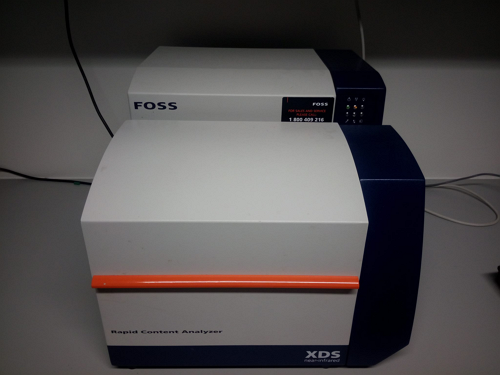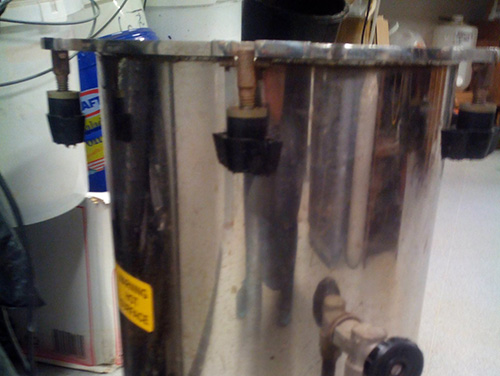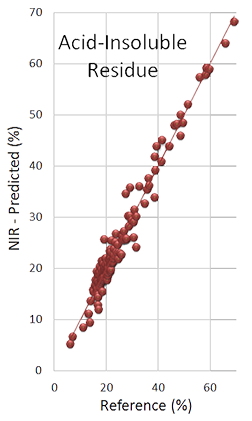Acid Insoluble Residue

The Acid Insoluble Residue (AIR) is the proportion of a sample that is not hydrolysed by 72% sulphuric acid. It is equal to the sum of the Klason Lignin content and the Acid Insoluble Ash content.
Click here to place an order for determining Acid Insoluble Residue.
Analysis Packages for Acid Insoluble Residue
The Celignis Analysis Package(s) that determine this constituent are listed below:
P8 Lignin Content |
|---|
| Lignin (Klason), Lignin (Acid Soluble), Acid Insoluble Residue, Ash (Acid Insoluble) |
P9 Lignocellulosic Sugars and Lignin |
|---|
| Total Sugars, Glucose, Xylose, Mannose, Arabinose, Galactose, Rhamnose, Lignin (Klason), Lignin (Acid Soluble), Acid Insoluble Residue, Ash (Acid Insoluble) |
Analytical Procedure for Acid Insoluble Residue
Step 1: Acid Hydrolysis of the Sample
When this Method is the first step in the Analysis Package, the acid hydrolysis takes place on the biomass sample with no prior extraction carried out at Celignis. If previous Steps involving the extraction of the sample have take place then the extracted material is used for the acid hydrolysis.
In the case where three different types of extracted material exist (water-extracted, ethanol-extracted, and water- then ethanol-extracted) then the sample that has undergone both water and ethanol extraction is typically used for acid hydrolysis, unless otherwise requested by the customer.
The following steps are involved in the acid hydrolysis of a sample.
1. The moisture content of the sample is determined, in duplicate.
2. Approximately 300 mg (with the exact weight noted) of the sample is added to a pressure tube.
3. 3.00 mL of 72% H2SO4 is added by means of an automatic titrator, the weight of the acid added is noted.
4. The sample is mixed thoroughly with the acid using a glass rod, care is taken that no sample stays adherent to the sides of the tube, but instead stays in contact with the acid.
5. The tube is transferred to a water bath that is maintained at 30 degrees celcius.
6. Steps 2-5 are repeated for the duplicate sample.
7. Every 10 minutes the glass rod for each pressure tube is stirred so that the acid reaches all parts of the sample and complete hydrolysis occurs. This is a crucial step.
8. Exactly one hour after it is placed in the water bath the pressure tube is removed and placed on a scales and 84 mL of water added (with the weight of the added water recorded). Any acid/sample on the rod is removed from the rod at this point using this water.
9. A lid is screwed on the tube and the tube is inverted several times to ensure thorough mixing of the acid.
10. Two sugar recovery solution (SRS) pressure tubes are prepared in order to monitor the sugar-loss associated with the second-stage-hydrolysis. This involves the following steps:
(a) 348 microlitres of 72% H2SO4 is added to a test tube containing a solution containing a known weight (approximately 10 g) of a sugar standard. This standard should be of a similar sugar composition to that expected of the samples being analysed. The acid and sugar solution are thoroughly mixed.
(b) The sugar-acid mixture is transferred to a pressure tube which is then sealed.
11. All SRS and sample pressure tubes are placed in an autoclave which is run at 121 degrees celcius for 60 minutes.
12. After the temperature in the autoclave drops to under 80C the tubes are removed and are left (closed) in the lab until they reach room temperature.
13. The hydrolysates are then filtered (using vacuum suction) through filter crucibles of known weight and the resulting filtrate is stored.
14. Any residual solids are washed out from the tube using deionised water until all the Acid Insoluble Residue resides on the filter crucible.
In the case where three different types of extracted material exist (water-extracted, ethanol-extracted, and water- then ethanol-extracted) then the sample that has undergone both water and ethanol extraction is typically used for acid hydrolysis, unless otherwise requested by the customer.
The following steps are involved in the acid hydrolysis of a sample.
1. The moisture content of the sample is determined, in duplicate.
2. Approximately 300 mg (with the exact weight noted) of the sample is added to a pressure tube.
3. 3.00 mL of 72% H2SO4 is added by means of an automatic titrator, the weight of the acid added is noted.
4. The sample is mixed thoroughly with the acid using a glass rod, care is taken that no sample stays adherent to the sides of the tube, but instead stays in contact with the acid.
5. The tube is transferred to a water bath that is maintained at 30 degrees celcius.
6. Steps 2-5 are repeated for the duplicate sample.
7. Every 10 minutes the glass rod for each pressure tube is stirred so that the acid reaches all parts of the sample and complete hydrolysis occurs. This is a crucial step.
8. Exactly one hour after it is placed in the water bath the pressure tube is removed and placed on a scales and 84 mL of water added (with the weight of the added water recorded). Any acid/sample on the rod is removed from the rod at this point using this water.
9. A lid is screwed on the tube and the tube is inverted several times to ensure thorough mixing of the acid.
10. Two sugar recovery solution (SRS) pressure tubes are prepared in order to monitor the sugar-loss associated with the second-stage-hydrolysis. This involves the following steps:
(a) 348 microlitres of 72% H2SO4 is added to a test tube containing a solution containing a known weight (approximately 10 g) of a sugar standard. This standard should be of a similar sugar composition to that expected of the samples being analysed. The acid and sugar solution are thoroughly mixed.
(b) The sugar-acid mixture is transferred to a pressure tube which is then sealed.
11. All SRS and sample pressure tubes are placed in an autoclave which is run at 121 degrees celcius for 60 minutes.
12. After the temperature in the autoclave drops to under 80C the tubes are removed and are left (closed) in the lab until they reach room temperature.
13. The hydrolysates are then filtered (using vacuum suction) through filter crucibles of known weight and the resulting filtrate is stored.
14. Any residual solids are washed out from the tube using deionised water until all the Acid Insoluble Residue resides on the filter crucible.
Step 2: Gravimetric Determination of Klason Lignin
The following steps are involved in the gravimetric determination of the Klason Lignin, Acid Insoluble Residue, and Acid Insoluble Ash contents:
1. The filter crucibles from the Acid Hydrolysis Step are placed in an oven overnight and dried at 105C.
2. These crucibles are then weighed to determine the Acid Insoluble Residue content.
3. The crucibles are then placed in a Nabertherm L-240H1SN muffle furnace and the following program used:
(i) Ramp from room temperature to 105C.
(ii) Hold at 105C for 12 minutes.
(iii) Ramp to 250C at 10C/minute.
(iv) Hold at 250C for 30 minutes.
(v) Ramp to 575C at 20C/ minute.
(vi) Hold at 575C for 180 minutes.
(vii) Allow temperature to drop to 105C.
(viii) Hold at 105C until the samples are removed.
4. The fiter crucibles are then weighed and the Acid Insoluble Residue, and Acid Insoluble Ash content calculated.
5. The Klason Lignin content is then calculated by subtracting the Acid Insoluble Ash content from the Acid Insoluble Residue content.
1. The filter crucibles from the Acid Hydrolysis Step are placed in an oven overnight and dried at 105C.
2. These crucibles are then weighed to determine the Acid Insoluble Residue content.
3. The crucibles are then placed in a Nabertherm L-240H1SN muffle furnace and the following program used:
(i) Ramp from room temperature to 105C.
(ii) Hold at 105C for 12 minutes.
(iii) Ramp to 250C at 10C/minute.
(iv) Hold at 250C for 30 minutes.
(v) Ramp to 575C at 20C/ minute.
(vi) Hold at 575C for 180 minutes.
(vii) Allow temperature to drop to 105C.
(viii) Hold at 105C until the samples are removed.
4. The fiter crucibles are then weighed and the Acid Insoluble Residue, and Acid Insoluble Ash content calculated.
5. The Klason Lignin content is then calculated by subtracting the Acid Insoluble Ash content from the Acid Insoluble Residue content.
Equipment Used for Acid Insoluble Residue Analysis

| NIR Spectrophotometers We have several FOSS XDS NIR devices. These have solid content modules, that can allow for samples of a heterogenous particle to be analysed, and liquid modules that allow liquids to be analysed via transmittance spectroscopy. |

| Autoclave An autoclave is used in the protocols for the determination of the lignin and structural sugars (cellulosic and hemicellulosic) contents of samples. |
NIR Model
Acid Insoluble Residue Global 1
This model has been built from a global dataset comprising a wide variety of biomass samples. Click here for a list of the types of samples that were used to build this model.
The samples were air-dried and then ground-down to a particle size of less than 850 microns prior to NIR analysis.
Model Statistics
| Min. Value (%) | 0.12 |
|---|---|
| Max. Value (%) | 72.64 |
| Calibration Samples | 482 |
| Validation Samples | 163 |
| R2 (Validation) | 0.969 |
| RMSEP (%) | 1.976 |
| Bias (%) | 0.002 |
| SEP (%) | 1.982 |
| RPD | 5.616 |
| RER | 31.857 |
Regression Plot
(Independent Validation Set)

Feedstock Specific Data
Regression statistics for specific biomass types along with the values for the Deviation in Prediction (Dev.).
| Feedstock Type | Dev. | R2 | RMSEP |
|---|---|---|---|
| Wood | Av 2.23 | 0.899 | 1.324 |
| Herbaceous | Av
1.32 |
0.934 |
0.932 |
Additional Material
We can determine the Acid Insoluble Residue content of biomass, click here to learn more about our various biomass analysis methods.





